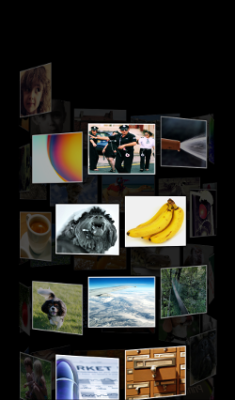ItemView
PUBLISHED
The Dali::Toolkit::ItemView class is a scrollable container that can contain many items. It provides several scrollable layouts, as illustrated in the following figure.
Figure: ItemView layouts
| Grid | Spiral | Depth |
 |
 |
 |
You can also create your own custom layout by inheriting from the Dali::Toolkit::ItemLayout class.
In this tutorial, the following subjects are covered:
ItemView events
The following table lists the basic signals provided by the Dali::Toolkit::ItemView class.
Table: Dali::Toolkit::ItemView input signals
| Input signal | Description |
|---|---|
LayoutActivatedSignal() |
Emitted when layout activation is finished. |
Implementing ItemFactory
To create a Dali::Toolkit::ItemView instance, you must create your own ItemFactory class by deriving from the Dali::Toolkit::ItemFactory class and providing its instance to the ItemView::New() function. ItemFactory is an abstract class having 2 pure virtual member functions to create items and get the number of created items. The following basic example shows how to implement an ItemFactory class:
class MyFactory : public ItemFactory
{
public:
virtual unsigned int GetNumberOfItems()
{
// Return the number of items
return MY_ITEM_COUNT;
}
virtual Actor NewItem( unsigned int itemId )
{
// Create the actor representing
// the item based on the itemId
return ImageView::New( MY_IMAGE_PATHS[itemId] );
}
};
The overridden functions in the derived class are called by the ItemView object.
Creating an ItemView
The following basic example shows how to create a Dali::Toolkit::ItemView object:
class HelloWorldExample : public ConnectionTracker
{
// Store a factory as a member variable
MyFactory mFactory;
};
void HelloWorldExample::Create( Application& application )
{
// Create an ItemView with the factory
ItemView itemView = ItemView::New( mFactory );
itemView.SetParentOrigin( ParentOrigin::CENTER );
// Create a layout
ItemLayoutPtr spiralLayout = DefaultItemLayout::New( DefaultItemLayout::SPIRAL );
// Add the layout to the itemView
itemView.AddLayout( *spiralLayout );
// More layouts can be created and added to the itemView
// Activate the layout
itemView.ActivateLayout( 0, Vector3( Stage::GetCurrent().GetSize() ), 0 );
// Add the itemView to the stage
Stage::GetCurrent().Add( itemView );
}
ItemView Properties
The following table lists the available ItemView properties.
Table: ItemView properties
| Property | Type | Description |
|---|---|---|
MINIMUM_SWIPE_SPEED |
FLOAT | The minimum swipe speed in pixels per second |
MINIMUM_SWIPE_DISTANCE |
FLOAT | The minimum swipe distance in actor coordinates |
WHEEL_SCROLL_DISTANCE_STEP |
FLOAT | The step of scroll distance in actor coordinates for each wheel event received |
SNAP_TO_ITEM_ENABLED |
BOOLEAN | Whether the animation for the layout to scroll to its anchor position after dragging or swiping is enabled |
REFRESH_INTERVAL |
FLOAT | The interval between refreshes |
LAYOUT |
ARRAY | The layout used |
LAYOUT_POSITION |
FLOAT | The current logical position within the layout |
SCROLL_SPEED |
FLOAT | The scrolling speed when playing the flick animation |
OVERSHOOT |
FLOAT | The amount that we can scroll beyond the boundary |
SCROLL_DIRECTION |
FLOAT | The current scrolling direction |
LAYOUT_ORIENTATION |
INTEGER | The current orientation of the layout |
SCROLL_CONTENT_SIZE |
FLOAT | The size of the content |
Was this document helpful?
We value your feedback. Please let us know what you think.


